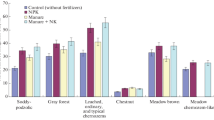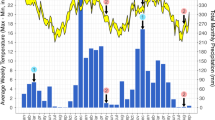Abstract
Humification of organic matter in the soil plays many parts. Classical chemical fractionation of soil organic matter differentiates between different kinds of soil but throws no light on the effects of husbandry within any one soil type. Therefore, to evaluate the quality of the soil organic matter in an arable chernozem, we have applied indices of the water-soluble and alkali-soluble fractions of soil organic matter, coefficient of extinction and C:N ratio. Results indicate that, under arable, an insufficient supply of fresh organic matter is contributing to the progressive loss of humus, leaching of the water-soluble fraction and other negative consequences.
Access provided by Autonomous University of Puebla. Download chapter PDF
Similar content being viewed by others
Keywords
These keywords were added by machine and not by the authors. This process is experimental and the keywords may be updated as the learning algorithm improves.
1 Introduction
A soil’s organic matter is an integrating index of fertility but, in evaluating soil quality, we should consider qualitative changes of composition of the soil organic matter as well as its total amount. Classical chemical fractionation of soil organic matter reveals differences between soil types (Kononova 1963; Orlov 1974; Alexandrova 1980; Licov et al. 1981, 2004) but does not distinguish the effects of different agronomic practices on the quality of soil organic matter in any one type of soil.
Soil organic matter is an amalgam of fractions at different stages of decomposition, but the direction and intensity of humification is determined by the labile fraction. Earlier, we investigated several indicators of the quality of soil organic matter (Licov et al. 1981, 2004; Boincean 1999). In this chapter we apply a few of these indicators to evaluate soil organic matter quality in the Balti chernozem under the Selectia long-term field experiments.
2 Materials and Methods
The design of the Selectia long-term field experiment with different crop rotations and continuous cultures has already been described. Here we use the contents of water-soluble soil organic matter and the fraction soluble in 0.1 M NaOH as indicators of soil organic matter quality under contrasting regimes in the long-term experiment. A key point is that analyses were carried out on the whole extract, without the further denaturing involved in the conventional procedure for separating humic and fulvic acids. The content of carbon in the alkaline extract was determined at different stages of the growing season using the Tiurin spectrophotometric procedure. The coefficient of extinction, which indicates the capacity of dissolved humic substances to decrease the intensity of light penetrating through a 1 cm layer of the alkaline extract, was determined for the whole visible spectrum. Following Kononova (1963), we take it that the younger the humic substances, the lower are the coefficients of extinction, and the older the humic components, the higher are the coefficients of extinction. This regularity is determined by the dominance of more condensed aromatic carbon compounds in older humic substances and more aliphatic components in younger humic substances.
3 Results and Discussion
Tables 23.1 and 23.2 present data on content of labile organic matter under meadow, crop rotations, continuous wheat, continuous maize and black fallow in the 0–20 cm and 20–40 cm layers, respectively. Both layers show similar trends, although these are more pronounced in the surface layer.
The lowest amount of both water-soluble and alkali-soluble organic matter was found in both fertilized and unfertilized plots under continuous maize, even compared with black fallow. The coefficient of extinction for alkali solution was highest in the unfertilized plot of continuous maize.
The labile fraction comprises aliphatic and low-phenol components that are most active in stabilizing soil structure and which are, also, readily decomposed to yield soluble plant nutrients. Loss of labile soil organic matter means loss of such favourable agronomic characteristics as tilth, permeability and capacity to supply crops with nutrients. Such soils are perceptibly more compact and we may suppose that they will need greater applications of mineral fertilizers in order to achieve the same yield as those with more labile organic matter. This is proved by the long-term field experiments which demonstrate that the efficiency of mineral fertilizers is higher for continuous monocultures, maize in particular, than in crop rotations. The same holds for continuous winter wheat, although compared with continuous maize, continuous wheat provides more labile soil organic matter and the labile fraction contains more phenolic components.
The contents of water-soluble soil organic matter on unfertilized plots in crop rotation no.7 and rotation no.2 (with black fallow and the lowest rates of farmyard manure) are similar to, though higher than, under continuous maize. We suppose that a low input of fresh organic matter leads to more intensive destruction of the existing soil organic matter, especially when higher rates of mineral nitrogen are applied; black fallow is very destructive of soil organic matter (see also Table 23.3 in respect of the whole soil profile).
Crop rotation no.5, with perennial legumes, and rotations with higher rates of farmyard manure (1, 3 and 4) all have enhanced levels of water-soluble soil organic matter. However, each has a different content of alkali-soluble organic matter; the highest amounts are found in rotation no.5, which incorporates perennial legumes, and no.4 which receives the highest application of farmyard manure (12 t/ha). The coefficients of extinction for the labile organic fraction are also highest under these rotations, which indicate greater return of fresh organic matter to the soil – accompanied by much improved soil structure.
The content of labile soil organic matter under crop rotations is closer to that under meadow than to continuous cereals and black fallow. However, meadow and black fallow exhibit a similar structure of the labile fraction as indicated by the coefficient of extinction for the alkali-soluble fraction which is, in both cases, lower than under continuous cereals and much lower than under crop rotations. However, the directions of transformation of soil organic matter are opposite: under black fallow the humus being lost by decomposition, whereas under meadow, humus is accumulating.
Table 23.3 illustrates changes in the quality of the labile fraction of soil organic matter down the soil profile to a depth of one metre under crop rotation no.2 (with black fallow and low rates of farmyard manure) and rotation no.5 (which includes 30 % of perennial legumes). Under the rotation with black fallow, soil organic matter (especially the alkali-soluble fraction) is more mobile than in crop rotation with perennial legumes. Speaking about higher mobility, we mean a higher content of young humic substances.Footnote 1 The water-soluble fraction of soil organic matter is also more mobile under rotation no.2, except in the upper 30 cm. We deduce that compared with black fallow, the perennial legumes in the crop rotation are arresting the leaching of labile soil organic matter. This matters to farmers because loss of labile organic matter stimulates further decomposition of all the soil organic matter. Insufficient input of fresh organic matter intensifies soil degradation, and nitrates and pesticides can be leached through the soil to the groundwater; in short, the less-favourable the conditions for soil organic matter transformation in the topsoil, the greater the danger for soil degradation and pollution.
Tables 23.4 and 23.5 present total organic carbon and total nitrogen contents and the C/N ratio in soil layers 0–20 cm and 20–40 cm under different management. The highest contents of carbon and nitrogen are found under meadow. The lowest content of carbon is found under black fallow; however, the content of nitrogen in unfertilized black fallow was the same as the unfertilized plots of winter wheat (0.21 %) and total nitrogen was even lower in unfertilized plots under maize-for-grain (0.20 %). The C/N ratio was higher under continuous cereals (12.1–12.8), except for fertilized continuous winter wheat (which had the lowest content of total nitrogen).
Because fertilized plots of continuous cereals now have the lowest contents of soil organic matter, they present better opportunities for the accumulation of soil organic matter than plots under crop rotations. The lowest content of carbon in crop rotations is in unfertilized plots (no.7) and in the rotation with black fallow (no.2). The situation is the same in respect of total nitrogen. Both are determined by the turnover of soil organic matter, which is a complex process, and we need more detailed research to understand just what is going on.
4 Conclusions
-
1.
The content of labile soil organic matter is higher under crop rotations than under continuous cereals, especially on fertilized plots. Coefficients of extinction are higher under crop rotations and continuous cereals than under meadow and black fallow. The highest value (under continuous maize-for-grain) indicates accelerated decomposition of soil organic matter; decomposition is also severe under black fallow.
-
2.
The various indicators of soil organic matter quality should be interpreted with care, considering the simultaneous quantitative changes in soil organic matter. For instance, black fallow and meadow have different contents of alkali-soluble soil organic matter but similar values for the coefficient of extinction, which actually indicate opposite directions of the humification–decomposition processes.
-
3.
Insufficient addition of fresh organic matter to the soil is contributing to more-intensive decomposition of soil organic matter throughout the whole soil profile, which has many negative ecological consequences.
Notes
- 1.
Research is needed to further establish the agronomic significance of the ratio of soluble and mobile humic substances in the total amount of extracted organic components, e.g. in respect of the availability of nitrogen for crops.
References
Alexandrova LN (1980) Soil organic matter and processes of its transformation. Science, Leningrad (Russian)
Boincean BP (1999) Ecological agriculture in the Republic of Moldova (crop rotation and soil organic matter). Stiinta, Chisinau (Russian)
Kononova MM (1963) Soil organic matter. Academy of Science of USSR, Moscow (Russian)
Licov AM, Cernicov VA, Boincean BP (1981) Evaluation of soil organic matter through the characteristics of its labile fraction. Izvestia TSHA 5:65–70
Licov AM, Esikov AI, Novikov MN (2004) Soil organic matter of arable non-chernozem soils. VNIIPTIOU Academy of Agricultural Sciences of Russia, Moscow (Russian)
Orlov DS (1974) Humic acids in soils. Lomonosov Moscow State University, Moscow (Russian)
Author information
Authors and Affiliations
Corresponding author
Editor information
Editors and Affiliations
Rights and permissions
Copyright information
© 2014 Springer Science+Business Media Dordrecht
About this chapter
Cite this chapter
Boincean, B.P., Bulat, L.I., Bugaciuc, M.A., Cebotari, M., Cuzeac, V.V. (2014). Quality of Soil Organic Matter Under Crop Rotations and Continuous Cultures. In: Dent, D. (eds) Soil as World Heritage. Springer, Dordrecht. https://doi.org/10.1007/978-94-007-6187-2_23
Download citation
DOI: https://doi.org/10.1007/978-94-007-6187-2_23
Published:
Publisher Name: Springer, Dordrecht
Print ISBN: 978-94-007-6186-5
Online ISBN: 978-94-007-6187-2
eBook Packages: Earth and Environmental ScienceEarth and Environmental Science (R0)




